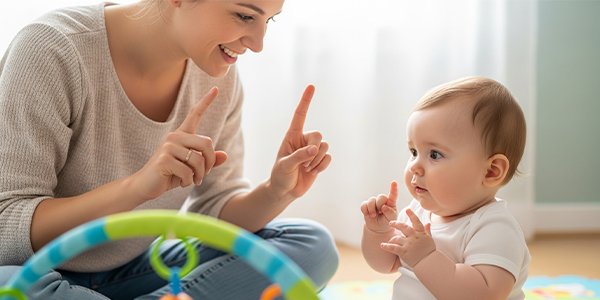All parents want to understand their baby’s needs and emotions. But language development is a gradual process. While a baby’s first words usually appear between 12 and 16 months, verbal communication often remains limited until around age 2. This period can be frustrating for both parents and the child. Fortunately, there is a powerful method to promote mutual understanding much earlier: baby sign language.
In this article, you’ll discover how this communication tool works, its everyday advantages, and why it’s a fantastic way to better understand your child.
What Is Baby Sign Language?
Baby sign language is a communication method based on adapted signs, designed specifically for hearing children and their parents. It’s often referred to as “gesture-based communication associated with speech” because spoken language is just as important as the gestures themselves!
In practice: Baby signing involves pairing each gesture with the corresponding spoken word. For example, when an adult says, “Were you scared?” or “Do you want some water?”, they simultaneously accompany the spoken sentence with the sign for “scared” or “water.” This helps the baby associate the gesture with the word and eventually imitate both.
And since a child’s motor development progresses faster than language development, little ones can “talk” using signs much earlier than with words! If you use baby sign language regularly, your child may begin to understand signs around 6 months and even start signing back between 9 and 12 months (on average).
Everyday words can be signed this way: hungry, thirsty, bottle, book, play, sleep, cuddle, and so on. This is how baby sign language enables young children to express their needs and emotions well before they can speak, bridging that frustrating communication gap.
Why Use Baby Sign Language with Your Child?
Implementing baby sign language offers numerous benefits beyond just reducing frustration:
- Early Communication: empowers your baby to express needs (like hunger or discomfort) and feelings long before they can form words.
- Reduced Frustration: For both parent and child! When babies can communicate, tantrums stemming from not being understood often decrease.
- Strengthened Bond: Shared communication builds a deeper connection and mutual understanding.
- Enhanced Language Development: Contrary to common misconceptions, using signs often encourages, rather than hinders, verbal language development. It helps babies understand the concept of communication itself.
- Boosted Confidence: When babies are understood, it builds their self-esteem and encourages further attempts at communication.
How to Learn Baby Signing with Your Child?
You don’t need any special skills or a lot of time to learn baby sign language!
The key is to rely on easy-to-use resources that fit into a busy parent’s life. Start with a few common signs (like “milk,” “more,” or “all done”) and integrate them naturally into your daily routines. Consistency is more important than perfection. Many online resources, books, and classes can guide you on this rewarding journey of communication with your little one.
Ready to start communicating with your baby even sooner? Give baby sign language a try and witness the amazing connection it can create!



